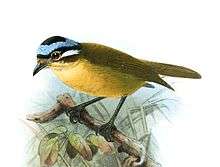Blue-capped ifrit
The blue-capped ifrit (Ifrita kowaldi), also known as the blue-capped ifrita, is a small and insectivorous passerine species currently placed in the monotypic family, Ifritidae.[2][3] Previously, the ifrit has been placed in a plethora of families including Cinclosomatidae or Monarchidae.[2] Blue-capped ifrits are considered an ancient relict species endemic to New Guinea. This corvoid species originally dates back to the Oligocene epoch, on a series of proto-Papuan islands, with minimal known evolutionary divergences.[4]
| Blue-capped ifrit | |
|---|---|
 | |
| Scientific classification | |
| Kingdom: | Animalia |
| Phylum: | Chordata |
| Class: | Aves |
| Order: | Passeriformes |
| Family: | Ifritidae Schodde & Christidis, 2014 |
| Genus: | Ifrita Rothschild, 1898 |
| Species: | I. kowaldi |
| Binomial name | |
| Ifrita kowaldi (De Vis, 1890) | |
Description
The blue-capped ifrit is 16–17 cm long and weighs 34-36g.[5] Species plumage is yellowish brown with a blue-black crown atop their broad head. It is a sexually dimorphic species, with ear streak coloration being white in males and more tawny yellow in females.[2] Ifrits tend to have more stout body shapes with broad sternums and shallow keels.[2] Their wings are short and rounded while their legs are booted, having feather down to their stout and clawed feet.[2] Additionally, blue-capped ifrits have batrachotoxin within their feathers and skin.[6]
Distribution and habitat
Blue-capped ifrits are endemic to New Guinea and Papua New Guinea, being found nowhere else on earth and having a distribution of 388,000 km2.[7] Ifrits inhabit montane rainforest of New Guinea, living in altitude ranges of 1000–4000 meters above sea level.[2] Typically, they are found at altitudes of 1500 meters or above.[3]
Behavior and ecology
As birds with weak flight abilities, blue-capped ifrits build nests about 1–3 meters above the ground in the branches of denser rainforest vegetation.[2] These nests are made of plant fibers with some feathers. The parents tend to camouflage the outside of the nest with moss and liverworts. Ifrits lay small clutches with a typical nest containing only a single offspring.[3] The nest camouflage, toxin excretion, and small clutch sizes may have derived from historically high rates of depredation and nest parasitism.[8]
Toxin
Blue-capped ifrits are among a small group of avian species that are poisonous, the others being the little shrikethrush (Colluricincla), and several members of the Pitohui, also from New Guinea. Ifrits excrete batrachotoxin into their feathers and skin in order to defend themselves against predators.[8] Generally, batrachotoxin binds and permanently opens the sodium channels in nerve cells and can cause paralysis[9]. The accumulation of toxins varies in individuals based on the region they are found in and this could be due to the availability of Choresine spp. beetles, which are speculated to be the dietary cause of the toxin itself.[10]
Conservation status
Ifrits are of least concern because they have a large range. Ifrits seem to have stable population and are thought to have quite a large population size.[5] Part of their range lies within conservation sites.[11]
See also
- Batrachotoxin
- Toxic birds
References
- BirdLife International (2012). "Ifrita kowaldi". IUCN Red List of Threatened Species. 2012. Retrieved 16 July 2012.CS1 maint: ref=harv (link)
- Schodde, Richard; Christidis, Les (2014-04-14). "Relicts from Tertiary Australasia: undescribed families and subfamilies of songbirds (Passeriformes) and their zoogeographic signal". Zootaxa. 3786 (5): 501–22. doi:10.11646/zootaxa.3786.5.1. ISSN 1175-5334. PMID 24869551.
- Donaghey, Richard H. (2015-09-07). "Nest and egg of the Dimorphic Fantail Rhipidura brachyrhyncha and a review of clutch-sizes in New Guinean passerines". Australian Field Ornithology. 32 (2).
- Jønsson, Knud Andreas; Borregaard, Michael Krabbe; Carstensen, Daniel Wisbech; Hansen, Louis A.; Kennedy, Jonathan D.; Machac, Antonin; Marki, Petter Zahl; Fjeldså, Jon; Rahbek, Carsten (2017-11-02). "Biogeography and Biotic Assembly of Indo-Pacific Corvoid Passerine Birds". Annual Review of Ecology, Evolution, and Systematics. 48 (1): 231–253. doi:10.1146/annurev-ecolsys-110316-022813. ISSN 1543-592X. S2CID 43763778.
- "Blue-capped Ifrit (Ifrita kowaldi)". www.hbw.com. Retrieved 2019-10-18.
- Bartram, Stefan; Boland, Wilhelm (2001-11-05). "Chemistry and Ecology of Toxic Birds". ChemBioChem. 2 (11): 809–11. doi:10.1002/1439-7633(20011105)2:11<809::aid-cbic809>3.0.co;2-c. ISSN 1439-4227. PMID 11948866.
- "LC Blue-capped Ifrit (Ifrita kowaldi)". Bird Life International. Retrieved 2019-01-27.
- Freeman, Benjamin G.; Mason, Nicholas A. (2014-01-08). "New Guinean passerines have globally small clutch-sizes". Emu - Austral Ornithology. 114 (4): 304–308. doi:10.1071/MU14023. ISSN 0158-4197. S2CID 83542583.
- "Batrachotoxin", Wikipedia, 2019-10-26, retrieved 2019-11-19
- Dumbacher, John P.; Wako, Avit; Derrickson, Scott R.; Samuelson, Allan; Spande, Thomas F.; Daly, John W. (2004-11-09). "Melyrid beetles (Choresine): A putative source for the batrachotoxin alkaloids found in poison-dart frogs and toxic passerine birds". Proceedings of the National Academy of Sciences. 101 (45): 15857–15860. doi:10.1073/pnas.0407197101. ISSN 0027-8424. PMC 528779. PMID 15520388.
- "The IUCN Red List of Threatened Species". IUCN Red List of Threatened Species. Retrieved 2019-10-18.
Bibliography
- del Hoyo, J.; Elliot, A. & Christie D. (editors). (2007). Handbook of the Birds of the World. Volume 12: Picathartes to Tits and Chickadees. Lynx Edicions. ISBN 978-84-96553-42-2
